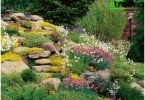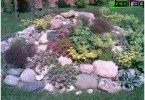We create a flowerbed of continuous flowering
How many of us did not freeze in amazement when we saw on the neighboring courtyard a real artistic canvas created from natural flowers? It pleases the eye in any season, surprising inexperienced gardeners. This is a method of planting vegetation, which is known as a flower bed of continuous flowering. What is the secret of creating a flower masterpiece, and how can you arrange such a flower garden on your site? Let’s find the answers to these questions together.
Content
- How does work on a flowerbed of continuous flowering begin
- How to choose a place for a continuously flowering flowerbed
- We make a flower bouquet for your flowerbed
- Important secrets from skilled flower growers to create flower beds
How does work on a flowerbed of continuous flowering begin
Since many flower gardens are enthusiastically compared with picturesque canvases, then work on it should be started by creating a sketch on a sheet of paper. That is, first of all, you need to imagine a flowerbed, what would you like to see it, and sketch a corresponding picture.
As a result, you should get a scheme in which multi-colored areas are harmoniously placed. However, it can be both monochrome and motley, which combines many shades.
After that, you can choose the right flower for each color. It is convenient to designate them by numbers, having painted for themselves what vegetation blooms in which period. Detailed recommendations on the choice of plant species will be given below..
It is worth noting that the flowers should be combined not only in their color: they come in completely different heights, so you need to imagine how the flowerbed will look in volume.
Another important nuance that must be remembered even at the planning stage is the consideration of the peculiarities of care for each flower, as well as the requirements of vegetation for the composition of the soil. Naturally, preference should be given to those species that need approximately the same growing conditions..
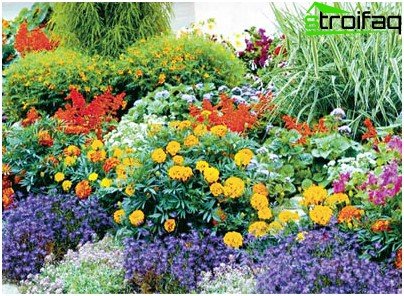
In the flower garden you can combine both annuals and perennials to make your work a little easier
How to choose a place for a continuously flowering flowerbed
The next question that remains to be decided is exactly where to place your flower garden on the site. When looking for the most suitable corner, you need to remember two points at once – where would you like to see your flower bed and how suitable are the conditions for growing flowers in the chosen place.
Of course, every novice gardener wants to see the creation of their hands in a corner where they can admire enough. In addition, the flowerbed should not violate the general harmony on the site. Finally, it must be placed in such a way that it does not interfere with movement within the territory, so that it is convenient to care for it.
At the same time, taking care of its pleasure and convenience, we should not forget about the interests of flowers. It is worth checking whether the soil suits them in the place you have chosen, whether the winds blow from all sides. By the way, we recall that in the daytime most of the plants with their heads follow the movement of the sun in the sky. So on the north side, the flower garden will look ugly: you will see the “wrong” side of the flower bed.
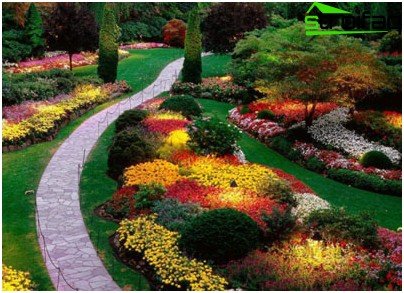
The flowerbed can be made the heart of the entire plot or arranged at the entrance to the summer cottage. Another good place to place it is near a track or recreation area.
We make a flower bouquet for your flowerbed
When you have a scheme of a bed of continuous flowering ready and a place selected for it, you can begin to carry out the task. We begin to plant flowers, adhering to several important recommendations.
First of all, we need to return to the question of choosing colors. It is no secret that some of them bloom earlier, while others later. Therefore, in order for the flowerbed to bloom continuously, it is necessary to make a composition so that the color of one vegetation replaces another.
For example, the very first spring crocuses, primrose, medunica, blueberries and forget-me-nots bloom. Thanks to them, your flower garden will come to life in those days when other plants can not boast even the presence of green mass.
Gentle-violet pulsatillas, as well as chamomile flowers, will bloom next. For example, you can plant doronicum, which will color the flower garden in sunny yellow until the end of April.
You can use other types of the chamomile family – feverfew of dark red or pink color, daisy-camomile. The latter, by the way, blooms for a very long time – until September.
In late spring – early summer, you can plant a large number of flowers. For example, a flowerbed will be elegant and cheerful if you plant violets, daisies, hyacinths in it. It is worth recalling another luxurious plant, which is called the royal crown or imperial grouse. Its flowers are large in size and saturated in orange. If desired, it can be entered into the big picture..
Of course, do not forget about the tender daffodils, and the lush peonies. They are immediately followed by many types of flowers that only need to be able to be combined in color and size – these are hydrangeas and gladioli, esholtius and rudbeckia, lobelia and asters. All of them bloom luxuriantly and colorful, as if giving for the last summer warmth before the traditional autumn wilting of nature.
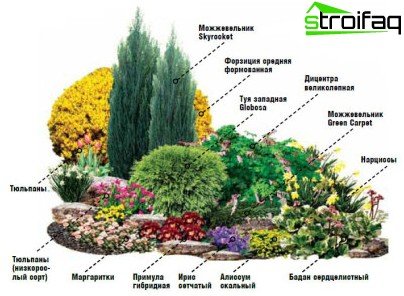
When compiling a diagram for a flower garden, one must take into account that in different regions there is a different flowering period of a particular plant. Therefore, the advice of experienced gardeners will be appropriate here, so as not to be mistaken with the timing
Chrysanthemums, dahlias, cannes, marigolds, phloxes, stonecrops will remind that autumn is already on the verge. And if we add to them alliums and craspedias blooming almost the entire season, then the flowerbed will not lose its colors until the cold snap.
Important secrets from skilled flower growers to create flower beds
Experienced gardeners do not always use a lot of flowers to form a flower garden that pleases the eye almost all year round. For example, diversity and beauty in a flowerbed can be achieved by combining just a few types of vegetation.
To do this, you need to know a few tricks:
- Firstly, the flowering season of the same plant can be extended by sowing it in several ways. For example, a flower is planted at home in a box for seedlings in February-March, then it is also sown in open ground. Thanks to this, the first flowers appear on the flowerbed a month and a half earlier than when sowing just in the ground.
- Secondly, it is worth choosing plants that are capable of repeated flowering for your flower garden. For example, if you remove the wilted flowers of the dolphinium and daylilies, bell and lupine, iris and daisies, then they will bloom one more time. You can also plant repairing carnations or roses, begonias or ageratum.
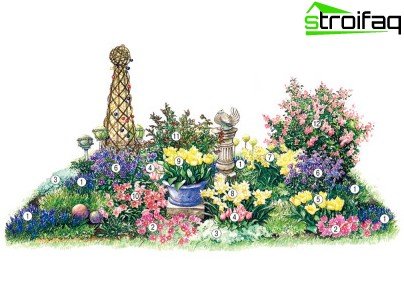
If among your home flowers there are those that can be taken outside for at least some period, feel free to add them to the scheme: this will give the flowerbed originality, as well as facilitate the work on it
- The third trick resorted to by knowledgeable growers helps to solve the question of how to restore beauty in a flowerbed, if suddenly its flowering has failed. This may be due to bad weather or other factors. In this case, solving the problem is simple – you can take home pots and flower boxes to the street. Having hidden them among dense vegetation, you will return to your attractive and harmonious look.



